TrueNAS SCALE [Community]
This is a community contribution and not officially supported by the Immich team, but included here for convenience.
Please report issues to the corresponding Github Repository.
Immich can easily be installed on TrueNAS SCALE via the Community train application. Consider reviewing the TrueNAS Apps tutorial if you have not previously configured applications on your system.
TrueNAS SCALE makes installing and updating Immich easy, but you must use the Immich web portal and mobile app to configure accounts and access libraries.
First Steps
The Immich app in TrueNAS SCALE installs, completes the initial configuration, then starts the Immich web portal. When updates become available, SCALE alerts and provides easy updates.
Before installing the Immich app in SCALE, review the Environment Variables documentation to see if you want to configure any during installation. You can configure environment variables at any time after deploying the application.
You can allow SCALE to create the datasets Immich requires automatically during app installation.
Or before beginning app installation, create the datasets to use in the Storage Configuration section during installation.
Immich requires seven datasets: library, pgBackup, pgData, profile, thumbs, uploads, and video.
You can organize these as one parent with seven child datasets, for example mnt/tank/immich/library, mnt/tank/immich/pgBackup, and so on.
The pgData dataset must be owned by the user netdata (UID 999) for postgres to start. The other datasets must be owned by the user root (UID 0) or a group that includes the user root (UID 0) for immich to have the necessary permissions.
Installing the Immich Application
To install the Immich application, go to Apps, click Discover Apps, either begin typing Immich into the search field or scroll down to locate the Immich application widget.
Click on the widget to open the Immich application details screen.
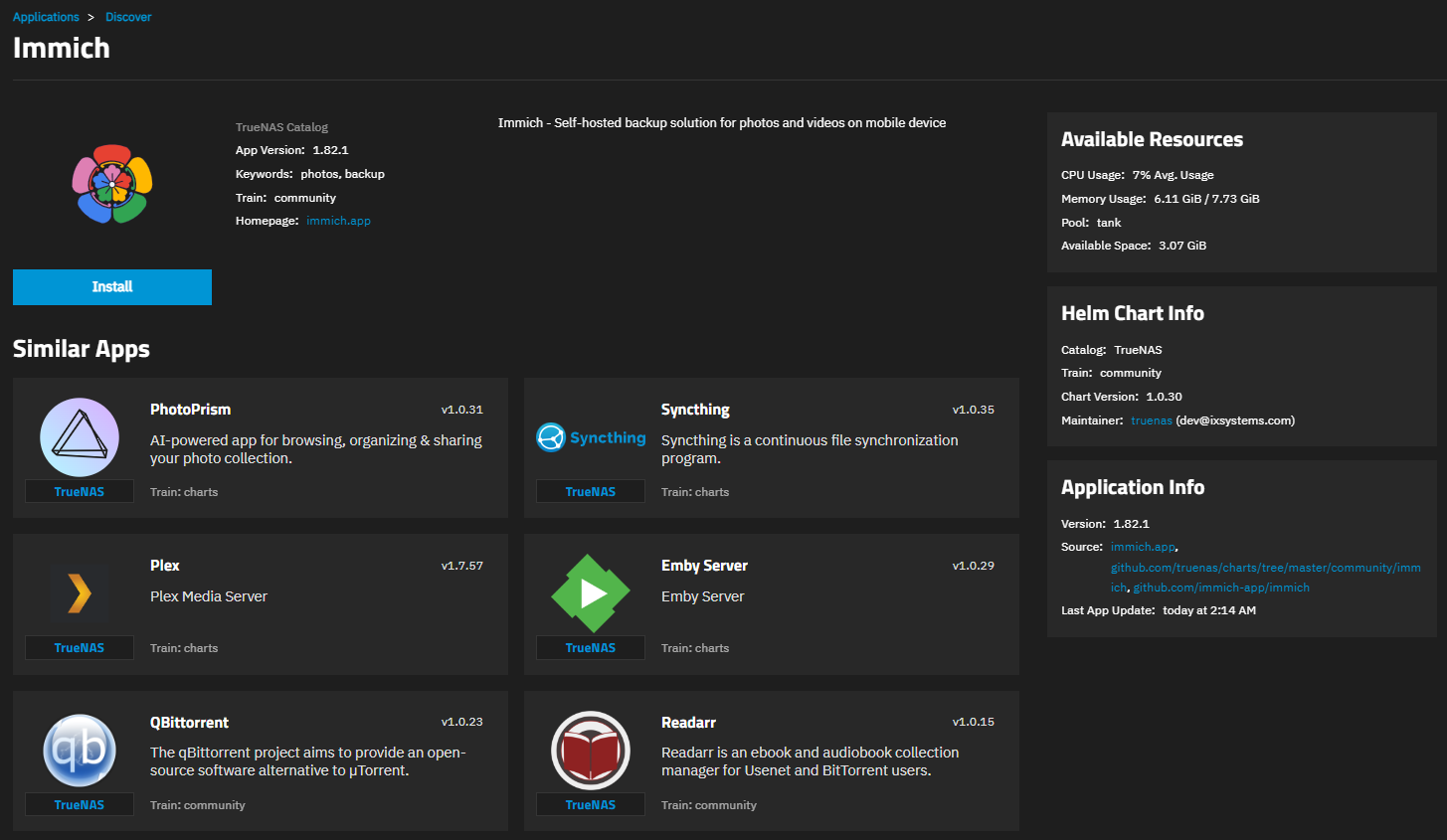
Click Install to open the Immich application configuration screen.
Application configuration settings are presented in several sections, each explained below. To find specific fields click in the Search Input Fields search field, scroll down to a particular section or click on the section heading on the navigation area in the upper-right corner.
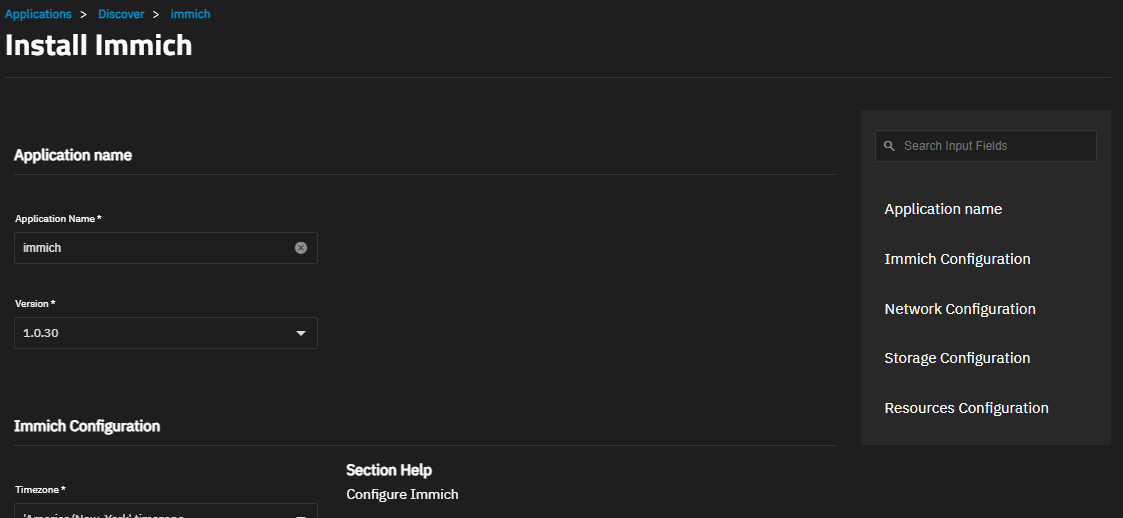
Accept the default values in Application Name and Version.
Accept the default value in Timezone or change to match your local timezone.
Timezone is only used by the Immich exiftool microservice if it cannot be determined from the image metadata.
Accept the default port in Web Port.
Immich requires seven storage datasets. You can allow SCALE to create them for you, or use the dataset(s) created in First Steps. Select the storage options you want to use for Immich Uploads Storage, Immich Library Storage, Immich Thumbs Storage, Immich Profile Storage, Immich Video Storage, Immich Postgres Data Storage, Immich Postgres Backup Storage. Select ixVolume (dataset created automatically by the system) in Type to let SCALE create the dataset or select Host Path to use the existing datasets created on the system.
Accept the defaults in Resources or change the CPU and memory limits to suit your use case.
Click Install. The system opens the Installed Applications screen with the Immich app in the Deploying state. When the installation completes it changes to Running.
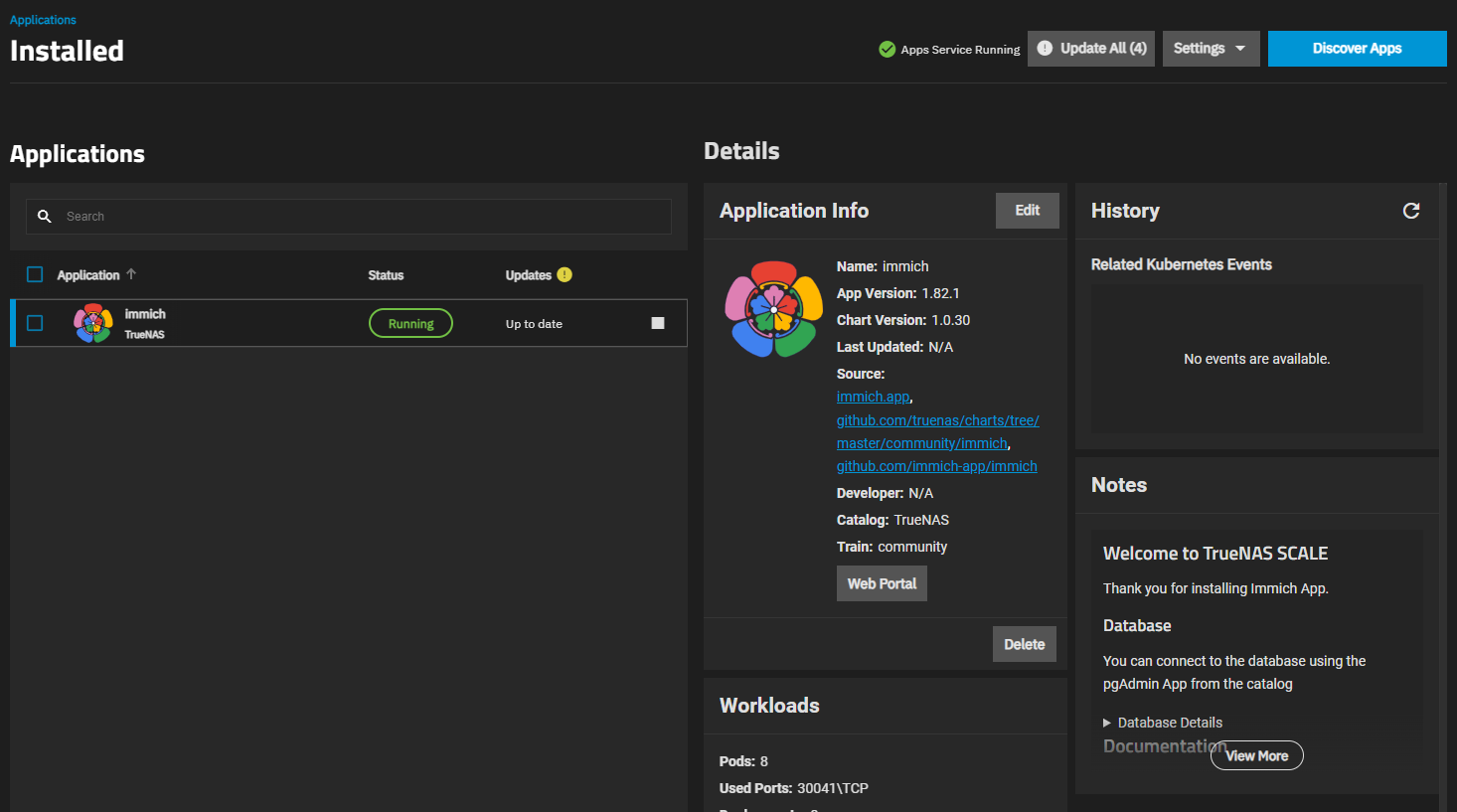
Click Web Portal on the Application Info widget to open the Immich web interface to set up your account and begin uploading photos.
For more information on how to use the application once installed, please refer to the Post Install guide.
Editing Environment Variables
Go to the Installed Applications screen and select Immich from the list of installed applications. Click Edit on the Application Info widget to open the Edit Immich screen. The settings on the edit screen are the same as on the install screen. You cannot edit Storage Configuration paths after the initial app install.
Click Update to save changes. TrueNAS automatically updates, recreates, and redeploys the Immich container with the updated environment variables.
Updating the App
When updates become available, SCALE alerts and provides easy updates. To update the app to the latest version, click Update on the Application Info widget from the Installed Applications screen.
Update opens an update window for the application that includes two selectable options, Images (to be updated) and Changelog. Click on the down arrow to see the options available for each.
Click Upgrade to begin the process and open a counter dialog that shows the upgrade progress. When complete, the update badge and buttons disappear and the application Update state on the Installed screen changes from Update Available to Up to date.
Understanding Immich Settings in TrueNAS SCALE
Accept the default value or enter a name in Application Name field. In most cases use the default name, but if adding a second deployment of the application you must change this name.
Accept the default version number in Version. When a new version becomes available, the application has an update badge. The Installed Applications screen shows the option to update applications.
Immich Configuration Settings
You can accept the defaults in the Immich Configuration settings, or enter the settings you want to use.
Accept the default setting in Timezone or change to match your local timezone.
Timezone is only used by the Immich exiftool microservice if it cannot be determined from the image metadata.
You can enter a Public Login Message to display on the login page, or leave it blank.
Networking Settings
Accept the default port numbers in Web Port. The SCALE Immich app listens on port 30041.
Refer to the TrueNAS default port list for a list of assigned port numbers. To change the port numbers, enter a number within the range 9000-65535.
Storage Settings
You can install Immich using the default setting ixVolume (dataset created automatically by the system) or use the host path option with datasets created before installing the app.
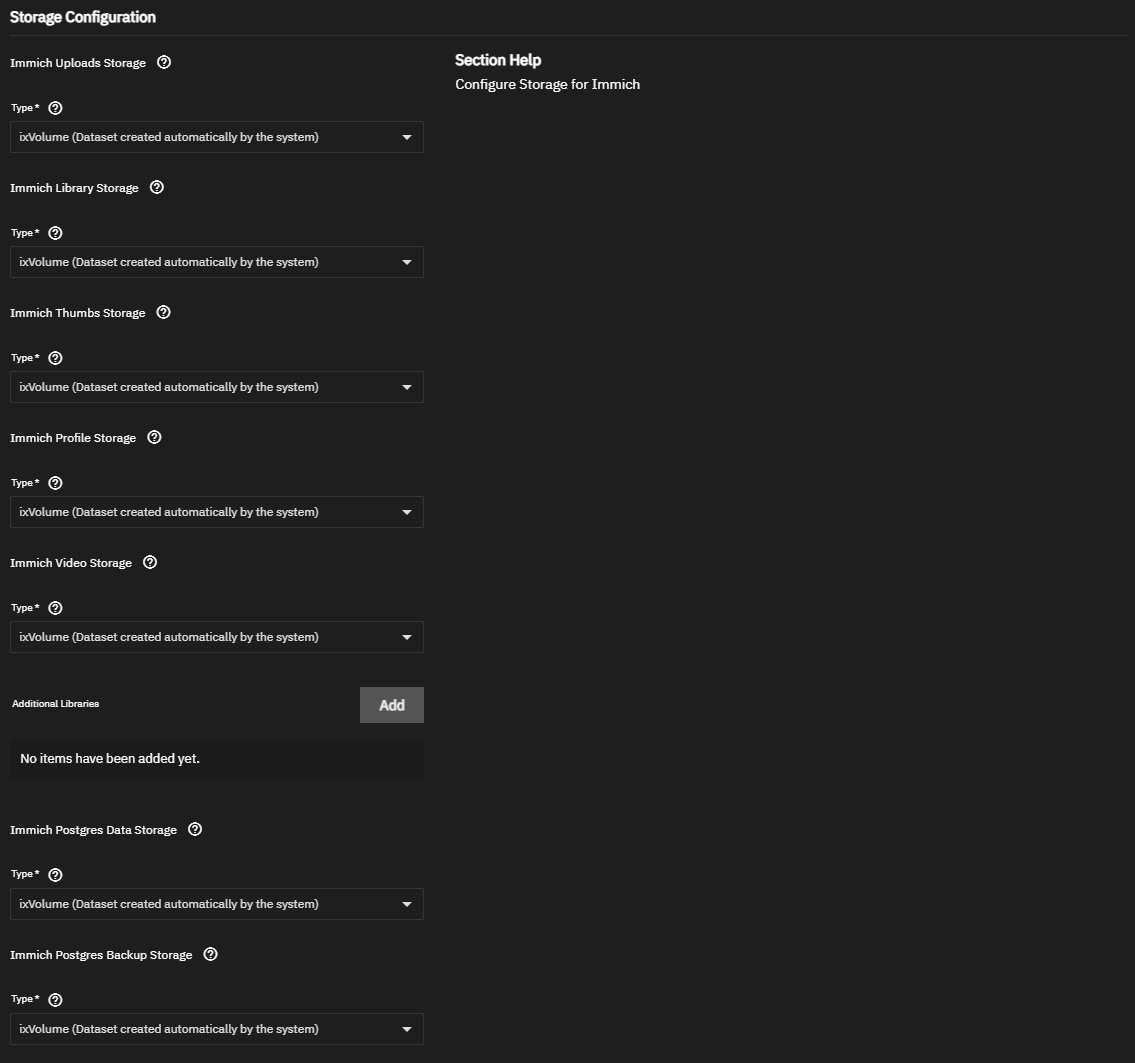
Select Host Path (Path that already exists on the system) to browse to and select the datasets.
Resource Configuration Settings
Accept the default values in Resources Configuration or enter new CPU and memory values By default, this application is limited to use no more than 4 CPU cores and 8 Gigabytes available memory. The application might use considerably less system resources.
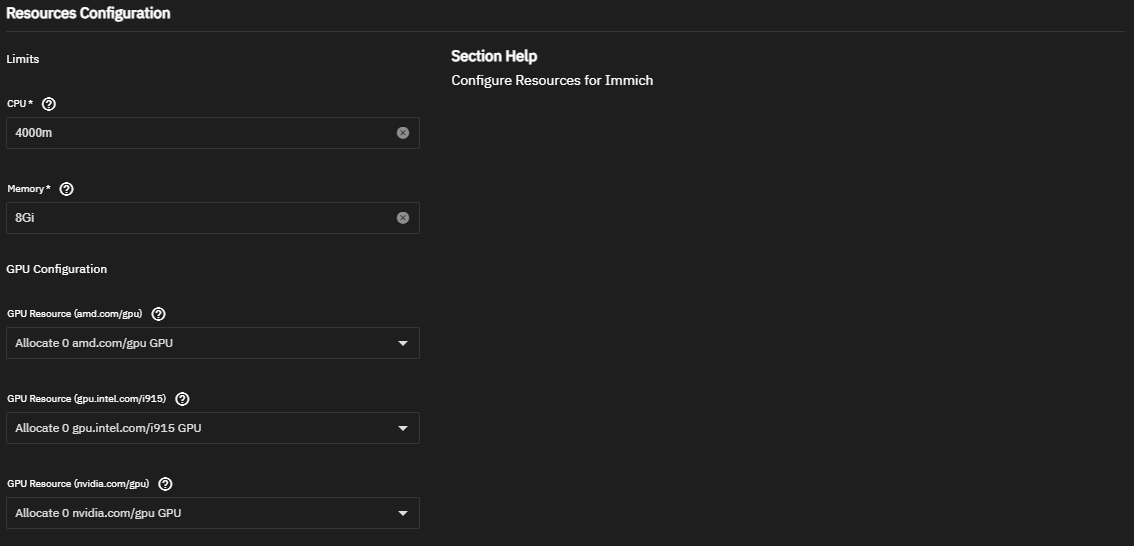
To customize the CPU and memory allocated to the container Immich uses, enter new CPU values as a plain integer value followed by the suffix m (milli). Default is 4000m.
Accept the default value 8Gi allocated memory or enter a new limit in bytes. Enter a plain integer followed by the measurement suffix, for example 129M or 123Mi.
Systems with compatible GPU(s) display devices in GPU Configuration. See Managing GPUs for more information about allocating isolated GPU devices in TrueNAS SCALE.